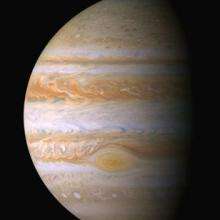December 21, 2011 report
New calculations suggest Jupiter's core may be liquefying

(PhysOrg.com) -- Jupiter, the largest planet in our solar system, may be causing its own core to liquefy, at least according to Hugh Wilson and colleague Burkhard Militzer of UC, Berkeley. They’ve come to this conclusion after making quantum mechanical calculations on the conditions that exist within the big planet. In a paper published on the preprint server arXiv, and submitted to Physical Review Letters, the two explain that because the gas giant has a relatively small core made of mostly iron, rock (partly magnesium oxide) and ice, and sits embedded in fluid hydrogen and helium all under great pressure from the planet’s gravity (which has created very high temperatures (16,000 K)), there is a likelihood that the core is liquefying due to the heat and pressure exerted on the magnesium oxide.
Calculating the possibility of the magnesium oxide liquefying had to be done to predict the outcome because recreating the environment that exists inside of Jupiter for experimentation purposes isn’t feasible. They have in essence shown that magnesium oxide, when exposed to such high temperatures and pressure, has high solubility, which of course means a high probability of dissolving into a liquid. In a previous study, the team also made calculations showing that the core ice would likely be dissolving as well.
The findings suggest that Jupiter’s core might not be as big as it once was, though it currently weights about as much as ten Earth’s (the whole planet weighs as much as 318 Earth’s). This implies that the core could eventually be reduced down to nothing at all. And if that’s the case, than those who study exoplanets, particularly the giant gas variety, will have to do some rethinking, because those others might not have a core at all, contrary to conventional wisdom.
Unfortunately, the calculations the two performed can’t give a rate of erosion, thus a timeline for how long it’s taken for the core to come to its current size can’t be made, nor can predictions be made on how long it might take for the core to disappear altogether; both of which would be useful in helping to predict the ages of other gas giants out beyond our solar system. Luckily, NASA has a space probe on the way to measure Jupiter’s gravitational field more accurately, though it won’t get there till 2016; that should give scientists plenty of time to consider the impact these new findings might have on their current models regarding giant gas planets.
More information: Rocky core solubility in Jupiter and giant exoplanets, arXiv:1111.6309v1 [astro-ph.EP] arxiv.org/abs/1111.6309
Abstract
Gas giants are believed to form by the accretion of hydrogen-helium gas around an initial protocore of rock and ice. The question of whether the rocky parts of the core dissolve into the fluid H-He layers following formation has significant implications for planetary structure and evolution. Here we use ab initio calculations to study rock solubility in fluid hydrogen, choosing MgO as a representative example of planetary rocky materials, and find MgO to be highly soluble in H for temperatures in excess of approximately 10000 K, implying significant redistribution of rocky core material in Jupiter and larger exoplanets.
via Wired
Journal information: Physical Review Letters
© 2011 PhysOrg.com





















